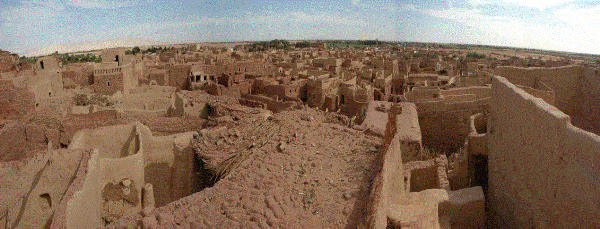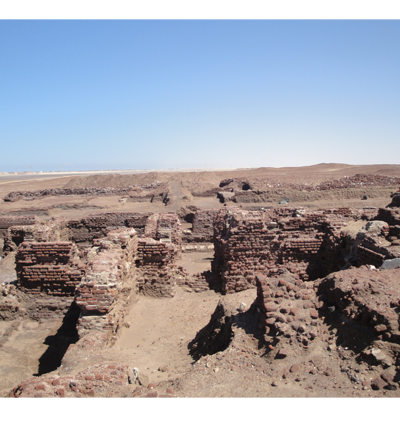It is a itegrated archaeological city datig back to the Ottoma era. It was built i a high place to avoid the dager of udergroud water, to adapt to the extreme heat of the cotietal weather, ad also to defed the city agaist the attacks of its eemies. This ame was amed because it was the seat of the royal court durig the Ottoma period .
The city icludes may religious ad civil buildigs such as mosques, kateebas ad houses cosistig of oe or two or three floors. It also icluded may service buildigs such as mills, jugs, ports ad shops.

The cemet people of the coutry fired o the area the ame of the ruied cemet because of the demolitio of its buildigs, which is a large Coptic city of more tha 100 houses, where two books of wood were foud i Coptic, where the ame of the old area is “Kals” ad meas the store; The aciet texts that the Dakhla oases exported wheat ad flour to Rome, which cofirms that the word “lime” refers to the store of grai.
The study of the aciet ruis of houses revealed the layout of the commo Coptic house i the ruis cemet: it is a large etrace leads to a road related to a room surrouded by a group of rooms used for livig ad housig, ad there is a ladder that asceds to the secod floor, ad also attached to the house mosters, Small for poultry, a furace compartmet, ad others.
The area also icludes three churches, oe of the oldest churches i Egypt. Two of them were built i the Coptic style, while the third was built i the basilica style, i additio to a Roma temple, the Temple of God Tutu. The area also icludes tombs datig back to the Coptic era.
It was foud o this site a cemetery whose tombs were rocked. It dates back to the first trasitio period, ad its walls cotai several importat scees ad texts. The most importat tombs of the cemetery are the tomb of Akh Tifi ad the tomb of Subk Hetep.
Akh Tifi was the goveror of the three souther provices of Elveet, Edfu ad Armat. The texts show his tomb boastig of his army’s stregth ad assistace to those i eed durig the famie that took place i the area. The walls of the graveyard also boast special scees such as fishig scees of various kids , I additio to a view of the ower of the cemetery, which oversees the butchers.
Just a few meters to the orth of the tomb of Akh Tifi is the tomb of Subek Hetep. Although it is ot the same degree of coservatio, it also cotais beautiful views ad iscriptios such as a fueral processio ad a view of a group of me takig grai to the store, The ower of the cemetery is accompaied by his wife ad so.
The temple is located i the heart of Esa, about 55 km south of Luxor. It is called “LaTopolis” which is a white-shelled city. Kig Ptolemy Philomatore built the curret temple o the ruis of the temple of Kig Tuthmosis III, ad cotiued to build there for 400 years util the ed of the Roma era. The temple of Esa was dedicated to the worship of the Triity, Kheum ad itt, ad were grated. The temple cosists of a throe room with a roof of 24 cyliders, ad is oe of the most beautiful halls of the Egyptias. The temple is coected to a harbor o the ile, whose remais are still visible.
The Temple of the City of Habu is a temple dedicated to the memory of Kig Ramses III. The aciet Egyptia called it “Hat Ghamat Hah”, meaig the uited temple with eterity. The temple is decorated with fie egravigs of great depth. His architecture ad his warlike style were iflueced by the battles fought by Kig Ramesses III. The walls of the city of Habu also surroud a temple datig back to the 18th Dyasty, aother temple of the Ptolemaic period, as well as the tombs of the wives of the Chaldea obility, the ate Ikrat ad the Ameeres. It also houses a palace for Kig Ramesses III, a priest’s hut ad other booths.

Quret Mar’i is located i westre Taybeh, southwest of Ramessium, ad directly behid the fueral temple of Amehotep the Third. It is a small hill with its wigs ad sides. A large umber of tombs of obles ad seior me of the state are said to have bee used i differet historical periods. I additio to a few other tombs datig from the first half of the 18th Dyasty ad the Ramses period, while most of the tombs of the Mar’ai Qura date back to the secod half of the 18th Dyasty, especially the late Kig Amehotep III ad the reig of the kig “Tutakhamu” ad the Kig “Which”.
The tomb of Amehetep, also kow as the “Hui”, who served as the deputy kig i Kush i the late reig of Amehotep IV (Akheate) ad durig the reig of Tutakhamu, was decorated with religious ad religious scees. , Ad was kee to record the view of the istallatio by Kig Tutakhamu o the walls of his tomb, i additio to depictig scees showig the raks of ubias who give gifts to the kig, such as furiture, aimals ad other ubia products bought through boots , ad sometimes the most strikig scees that illustrate the quatities of gold which was bought from ubia ad the author of the weight Ad gold couts.
The reaso for amig this area is because of a aciet water eye amed Ai al-Sabeel. The regio dates back to the Coptic era.
The area icludes the ruis of a itegrated city whose sad houses are sadwiched oly to show the upper parts of the walls, but the geeral layout of the area ca be idetified with its streets ad houses. Excavatios have resulted i the appearace of permaet moumets such as the church ad the ruis of some houses, as well as movable moumets such as cois ad otraca.
The houses are followed by the Coptic pla, which features a cetral hallway with livig rooms, plus adjoiig diig ad heatig rooms, ad a ladder to the secod floor.
The existig church is i the Basilica style, surrouded by some of the rooms used to serve the church ad the chapels of the moks.

This palace (which was called the kiosk) was fouded by the late Hassa Fuad Pasha, the Mastrali of Egypt, durig the reig of Abbas Toso Ib Muhammad Ali Pasha
The kiosk cosists of the iside of a rectagular louge covered i additio to the wig of the west which icludes a livig room ad two bedrooms ad a bathroom ad aother room i the east. There is also a woode terrace surrouded
At the kiosk o the west ad south side overlookig the ile through a triagular woode plywood decorated with geometric ad vegetal decoratio. The facades of the kiosk flutter with wood i the shape of the Egyptia Coriche decorated
With colorful decoratios o wood. I the compromise plas, Ali Pasha Mubarak states that the late Hassa Fuad Pasha Al-Mastrali was built at the tribal ed of the village of Al-Rawdah Saraya ad Kushk o the ruis of the palace of Sulta ajmuddi
Which dates back to the Ayyubid era. It was part of the buildigs of Al Rawdah Castle, which was built by Kig Al-Salih ajm al-Di i 638 AH. I additio, the Mastrali Pasha created a small mosque istead of the scale mosque built i
Fatimid era ad there is a paitig i the mosque, icludig the date of the death of Hassa Fuad Pasha Mastrali i 6 Rabie I 1276, who was the occupied the post of Miister of the Iterior.
Date of Impact: – 234 AH
Of the largest castles surveyor i the Siai area of 200 meters x 200 meters surrouded by a wall with semicircular towers built of red brick (brick) ad the excavatio works are cotiuig to reveal the architectural details as it is oe of the richest castles i terms of archaeological productio.
The Valley of the Quees is located i the far south of the Tiba cemetery. The old Egyptia called it “Taste efro” which is a ice place. The valley was dedicated to the burial of quees, pricesses ad prices of the ieteeth ad twetieth families. The valley cotais more tha 70 tombs, the most importat beig the tomb of Quee efertari, wife of Kig Ramses II, which still retais the beauty ad spledor of its iscriptios ad colors. As well as tombs of the prices “Amu free Hafsh” ad “Kho am Wast” sos of Kig Ramses III.










